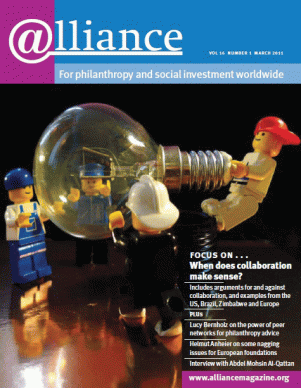Almost a decade ago, the Ford Foundation embarked upon an ambitious strategy to demonstrate that community philanthropy organizations could function as effective agents to expand economic, racial and social equity in the US. The goal was to increase the influence of local leaders in the non-profit, government and business sectors on promoting access and opportunity for local residents. This article looks at two community foundations and communities that Ford supported as part of this strategy.
The Foundation for the Mid South
The Foundation for the Mid South (FMS) was founded in 1990 through a consensus of civic and governmental leaders from Arkansas, Louisiana and Mississippi that the region needed a philanthropic organization to garner resources and civil society leadership to address long-standing disparities within communities. Regional corporations, local donors and the Ford Foundation were initial contributors to this then-new concept of a regional community foundation.
Some of the most notable signs of the foundation’s impact can be seen in the very rural state of Mississippi. From its founding, FMS recognized the long-standing racial divide that exists throughout the state. Families in small towns throughout the Mississippi Delta area, where African Americans are the predominant racial group, have seen only very slow improvements to their conditions in the past 40 or 50 years. One in five families lives below the US poverty level; the state has been slow to change its economy from an agricultural one to a skill-based one, creating unemployment rates of 18-20 per cent in some Delta communities.
Based on what it learned about the state’s inequities, both from listening to the experiences of community leaders and from its board members and staff, FMS identified key organizations and groups in one or two communities through which it could begin to dismantle some of the principal components of inequity. FMS began to make grants to non-profits and some public institutions in Greenwood and neighbouring towns, paying careful attention to the interrelatedness of social, economic and racial disparity as it appeared in that area.
Four grants, three of which are described below, along with the foundation’s consistent relationship-building with local leaders, have brought benefits for the community as well as encouraging functional leadership across racial, social and generational lines and helping the community begin to realize a vision of a revitalized place for all.
First, a $1.2 million investment in staff training and curriculum development in one of the area’s school districts has resulted in local public schools moving out of the ‘at risk of failing’ category (which means the school district could be taken over by the state) to one that recognizes improvement in teacher performance and student academic gains. The community and the foundation expect to see the district move to higher performance levels by the end of the grant. This grant, with technical support to the local school district, leveraged a $5 million federal school improvement grant.
Second, a $50,000 investment in a rural library near Greenwood has resulted in a community institution becoming a magnet for engaging young and old in the town in its rebuilding and programming processes.
Third, a $90,000 grant to the Greenwood Chamber of Commerce created and implemented a youth leadership programme to engage youth across racial lines in volunteering with local non-profits and government. Several of these youths have developed new relationships across racial lines to improve social and economic conditions and are committed to returning to the community after college.
For this subregion of small rural towns, shifting power from longtime traditional leaders to a larger group drawn from all sections of the community has been slow and difficult, but crucial to creating and sustaining equity. Throughout, FMS has been strengthening its credibility as a donor that recognizes the value of building the capacity within a community. Its analysis of the dynamics of community change in specific places has enabled it to use several of its philanthropic tools to facilitate equitable outcomes: racially and economically diverse decision-makers; improvements in area public institutions to enhance social capacity; and broad community giving to leverage regional investment.
The Black Belt Community Foundation
The Black Belt Community Foundation (BBCF) is a six-year-old community foundation in Selma, Alabama, in an area referred to as the Deep South of the US. It was founded by some unlikely partners: local civil rights activists, the private utility corporation for the state, a large (predominantly white) state university and several community leaders representing different socioeconomic lines, age groups and interests drawn from 12 rural counties in central Alabama.
At the outset, the foundation’s board set the goal of establishing a philanthropic resource that would address the economic and social disparities of the region and which would be ‘owned’ by Black Belt residents. The planning process for the foundation convened people in each of the area’s 12 counties to explain what a community foundation could do for the region and to hear what residents wanted from a foundation. BBCF’s mission – taking what we have to get what we need – is exemplified by the staff and board’s expertise in selecting grantees who can effectively leverage small grant dollars to attract new local donors as well as government investment. As an emerging community foundation, BBCF searched for and found an existing foundation that served rural counties in a nearby state with similar goals and values to be a mentor and provocateur in the design and implementation of a more inclusive community foundation.
Ford’s investment enabled the community foundation to train its board, staff and community volunteers about community philanthropy and then develop innovative practices to address the aspirations of its region. BBCF’s corps of 100 volunteers, known as community associates, publicize the work, vision and potential of the foundation to donors and non-profits throughout the region, face to face, raising money, attracting volunteers and identifying new grantees.
At the end of its fifth year of operations, and after $1.5 million in grantmaking, residents throughout the Black Belt see ‘their’ community foundation as an institution that is courageous enough to tackle racial and economic divides with integrated leadership. As it solidifies its values in the region, the BBCF will face one of its most difficult challenges – showing other organizations how to bring new leaders to its governance table, something which is new for the region. Another test of the foundation’s viability will be its decisions to focus its resources on improving living conditions – housing, education or job opportunities – in its communities.
Community change challenges residents and organizations to grapple with ideas or leadership that are unfamiliar or unknown. Community foundations who work on change strategies place themselves at the intersection of the status quo and imagination. The Foundation for the Mid South and the Black Belt Community Foundation are two examples of US community foundations that are driven by the passion to create tangible, measurable social change.
Linetta J Gilbert is co-leader of the Declaration Initiative, a movement committed to opportunities for justice that enables all to contribute to a healthy and thriving America. Email lgilbert@declarationinitiative.org
For more information
http://www.fndmidsouth.org
http://www.blackbeltfound.org
 Comment Jenny Hodgson
Comment Jenny Hodgson
It is not unusual for the dual objectives of local philanthropy development and the pursuit of a social change agenda to find themselves at odds with each other. For a community foundation, this can pose a particular challenge. Perhaps the biggest donors in a community are the least inclined towards changes in the status quo; or the development interests of the majority do not necessarily include the welfare of the minority or the marginalized; or else the structure of a community foundation’s board and staff does not reflect the makeup of the community it serves. For community foundations operating in contexts shaped by a history of racial injustice and entrenched and social divisions, such as the southern states of the US or, further afield, South Africa, with its history of apartheid, even the very notion of ‘community’ as a holistic concept can prove problematic.
As the cases of FMS and BBCF show, however, significant, tangible change can happen in even the least advantaged communities and it can be led by a community foundation. In both instances, multi-year grant support from the Ford Foundation certainly helped, as did the support of a programme officer who was personally invested in the process, as a mentor, adviser and advocate. Local leadership and an overarching vision for what success would look like were also key factors.
Perhaps most important, however, has been the consistent application of an equity lens across both foundations’ ways of working. This has created new opportunities for informal local leadership to emerge within the foundations’ structures (such as BBCF’s network of community associates who serve as the link between the foundation and individual communities). It has also allowed for an expanded notion of community assets, whether tangible (skills, materials, small donations) or intangible (participation, trust and community outlook) to serve as a cornerstone of FMS and BBCF’s work.
Jenny Hodgson is executive director of the Global Fund for Community Foundations. Email jenny@globalfundcf.org





Comments (0)